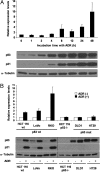Tumor-suppressive miR-34a induces senescence-like growth arrest through modulation of the E2F pathway in human colon cancer cells
- PMID: 17875987
- PMCID: PMC2000550
- DOI: 10.1073/pnas.0707351104
Tumor-suppressive miR-34a induces senescence-like growth arrest through modulation of the E2F pathway in human colon cancer cells
Abstract
Accumulating evidence suggests a role for microRNAs in human carcinogenesis as novel types of tumor suppressors or oncogenes. However, their precise biological role remains largely elusive. In the present study, we aimed to identify microRNA species involved in the regulation of cell proliferation. Using quantitative RT-PCR analysis, we demonstrated that miR-34a was highly up-regulated in a human colon cancer cell line, HCT 116, treated with a DNA-damaging agent, adriamycin. Transient introduction of miR-34a into two human colon cancer cell lines, HCT 116 and RKO, caused complete suppression of cell proliferation and induced senescence-like phenotypes. Moreover, miR-34a also suppressed in vivo growth of HCT 116 and RKO cells in tumors in mice when complexed and administered with atelocollagen for drug delivery. Gene-expression microarray and immunoblot analyses revealed down-regulation of the E2F pathway by miR-34a introduction. Up-regulation of the p53 pathway was also observed. Furthermore, 9 of 25 human colon cancers (36%) showed decreased expression of miR-34a compared with counterpart normal tissues. Our results provide evidence that miR-34a functions as a potent suppressor of cell proliferation through modulation of the E2F signaling pathway. Abrogation of miR-34a function could contribute to aberrant cell proliferation, leading to colon cancer development.
Conflict of interest statement
The authors declare no conflict of interest.
Figures




Similar articles
-
MicroRNA-34a inhibits migration and invasion of colon cancer cells via targeting to Fra-1.Carcinogenesis. 2012 Mar;33(3):519-28. doi: 10.1093/carcin/bgr304. Epub 2011 Dec 22. Carcinogenesis. 2012. PMID: 22198213
-
MicroRNA, SND1, and alterations in translational regulation in colon carcinogenesis.Mutat Res. 2010 Nov 10;693(1-2):94-100. doi: 10.1016/j.mrfmmm.2010.09.001. Epub 2010 Sep 29. Mutat Res. 2010. PMID: 20883704 Review.
-
MicroRNA-34a: a novel tumor suppressor in p53-mutant glioma cell line U251.Arch Med Res. 2010 Feb;41(2):67-74. doi: 10.1016/j.arcmed.2010.02.007. Arch Med Res. 2010. PMID: 20470934
-
MicroRNA-34a induces a senescence-like change via the down-regulation of SIRT1 and up-regulation of p53 protein in human esophageal squamous cancer cells with a wild-type p53 gene background.Cancer Lett. 2016 Jan 28;370(2):216-21. doi: 10.1016/j.canlet.2015.10.023. Epub 2015 Oct 30. Cancer Lett. 2016. PMID: 26523671
-
The miR-34 family in cancer and apoptosis.Cell Death Differ. 2010 Feb;17(2):193-9. doi: 10.1038/cdd.2009.56. Epub 2009 May 22. Cell Death Differ. 2010. PMID: 19461653 Review.
Cited by
-
MicroRNA and cancer.Mol Oncol. 2012 Dec;6(6):590-610. doi: 10.1016/j.molonc.2012.09.006. Epub 2012 Oct 9. Mol Oncol. 2012. PMID: 23102669 Free PMC article. Review.
-
LincRNA-EPS Promotes Proliferation of Aged Dermal Fibroblast by Inducing CCND1.Int J Mol Sci. 2024 Jul 12;25(14):7677. doi: 10.3390/ijms25147677. Int J Mol Sci. 2024. PMID: 39062918 Free PMC article.
-
miR-34 miRNAs Regulate Cellular Senescence in Type II Alveolar Epithelial Cells of Patients with Idiopathic Pulmonary Fibrosis.PLoS One. 2016 Jun 30;11(6):e0158367. doi: 10.1371/journal.pone.0158367. eCollection 2016. PLoS One. 2016. PMID: 27362652 Free PMC article.
-
Identification of colorectal cancer-restricted microRNAs and their target genes based on high-throughput sequencing data.Onco Targets Ther. 2016 Mar 24;9:1787-94. doi: 10.2147/OTT.S93338. eCollection 2016. Onco Targets Ther. 2016. PMID: 27069368 Free PMC article.
-
Tumor-suppressive effects of atelocollagen-conjugated hsa-miR-520d-5p on un-differentiated cancer cells in a mouse xenograft model.BMC Cancer. 2016 Jul 7;16:415. doi: 10.1186/s12885-016-2467-y. BMC Cancer. 2016. PMID: 27388711 Free PMC article.
References
Publication types
MeSH terms
Substances
LinkOut - more resources
Full Text Sources
Other Literature Sources
Molecular Biology Databases
Research Materials
Miscellaneous

